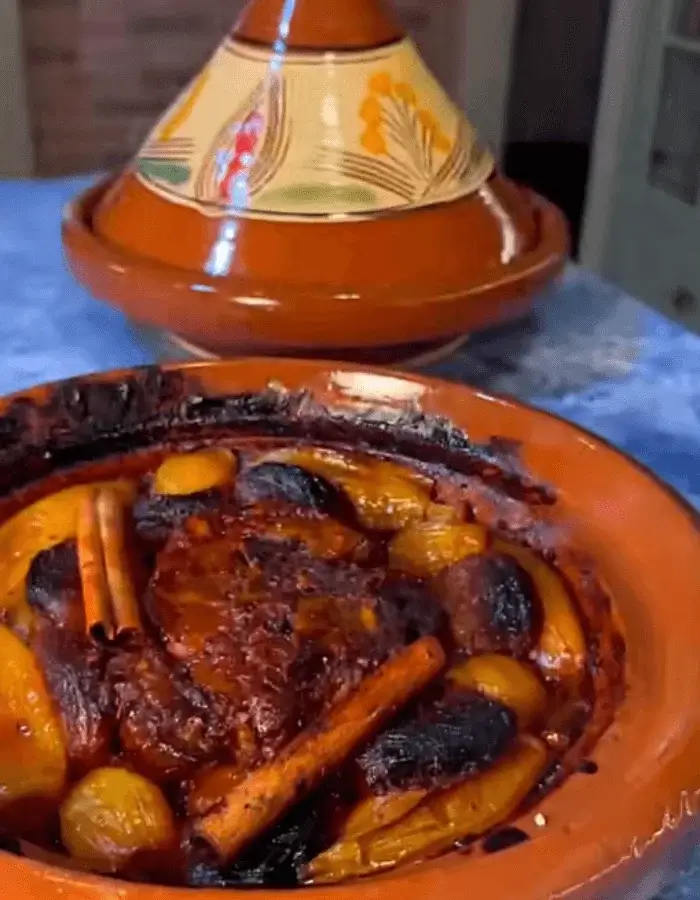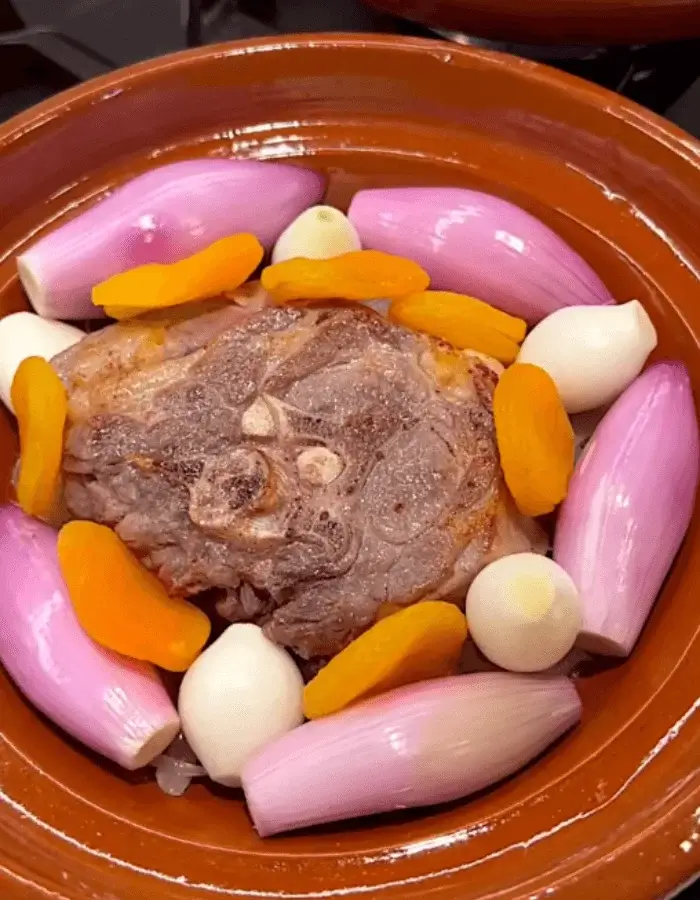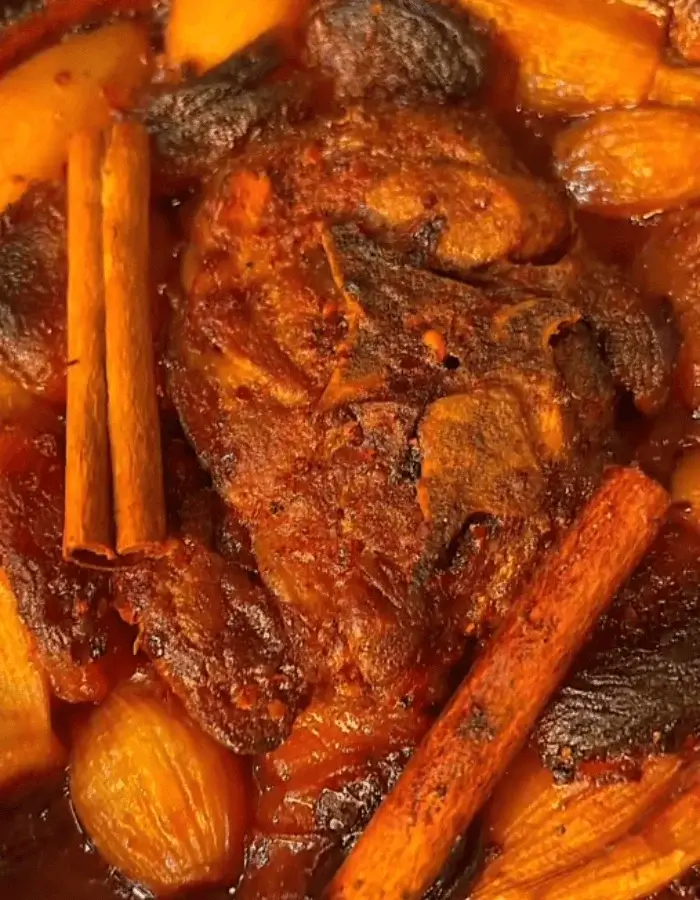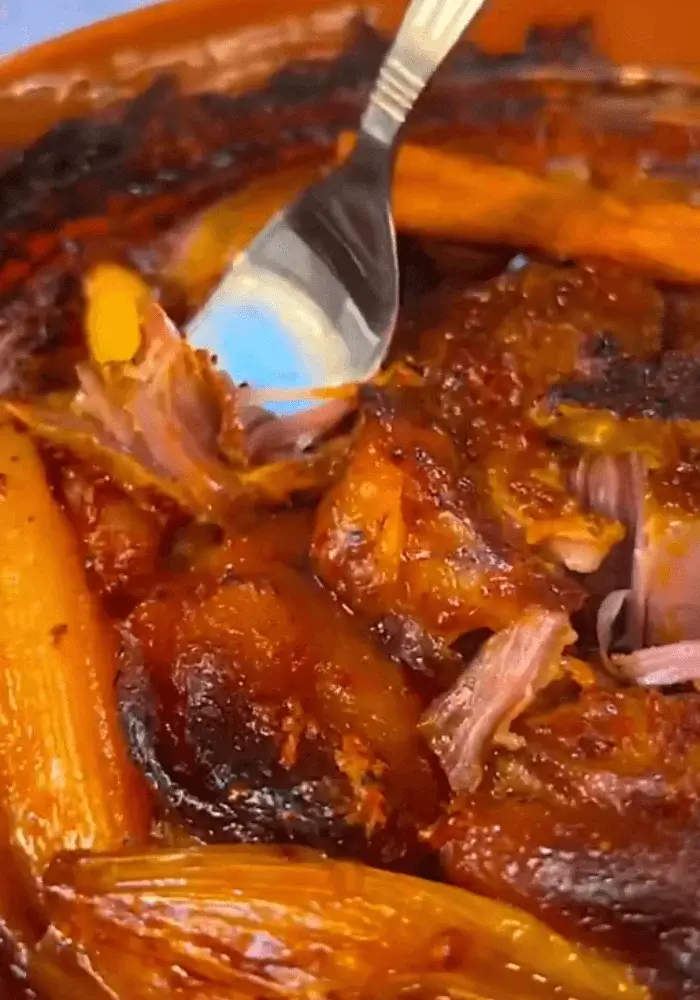Moroccan Lamb Tagine with Onions and Dried Apricots
We may earn a commission from recommended products, at no extra cost to you. See Disclosure.
- Tagine or Dutch oven
- Chef's knife
INGREDIENTS
- 2 pounds/900 grams lamb neck or osso buco
- 12 shallots or pearl onions
- 2 large onions, thinly sliced
- 12 dried apricots
- 2 tablespoons olive oil, plus more as needed
- 4 tablespoons date syrup
- 3 cinnamon sticks
Spice mix:
- 1 teaspoon ground turmeric
- 1 tablespoon sweet paprika
- 1 teaspoon ground black pepper
- 1 cup boiling water
- 2 flat teaspoons coarse salt
INSTRUCTIONS
- Using a large chef’s knife, trim and pat the lamb slices dry. In a large sauté pan or Dutch oven, heat the olive oil over medium heat. Add the sliced onions and cook, stirring occasionally, until deeply caramelized, 25 to 30 minutes. Transfer the onions to the bottom of a tagine base or a deep 9-by-13-inch/23-by-33 cm oven-safe baking dish.
- In the same pan, sear the lamb slices for 1 to 2 minutes per side until browned but not cooked through. Arrange them on top of the caramelized onions. Scatter the shallots and dried apricots around the lamb.
- In a small heatproof bowl or liquid measuring cup, mix the turmeric, paprika, and pepper with the boiling water. Stir well and pour the mixture evenly over the lamb and vegetables. Drizzle the date syrup and a bit more olive oil over the top. Nestle in the cinnamon sticks and season generously with coarse salt. Cover the surface with parchment paper, then seal tightly with the tagine lid or foil if using a baking dish.
- Preheat the oven to 320°F (160°C).
- Transfer the tagine or dish to the oven and bake for about 4 hours, until the lamb is tender and the flavors have melded. Remove from the oven and let rest, covered, for 10 to 15 minutes before serving.
- Serve warm with couscous, rice, or crusty bread to soak up the rich sauce.

FAQ
What cut of lamb works best for this recipe?
The best cuts are those suited for long, slow cooking. Lamb neck, shoulder, or shank are ideal because they contain connective tissue and marbling that break down during braising, resulting in tender, flavorful meat. These cuts benefit from the tagine’s gentle, moist heat, which allows the spices and aromatics to fully penetrate the meat. Osso buco (cross-cut lamb shanks) is also a good choice, as it includes both bone and marrow, which add richness to the dish. Avoid lean cuts like leg of lamb, which can become dry and tough in slow-cooked dishes like Moroccan lamb tagine.

Can I make this dish without a traditional tagine pot?
A Dutch oven or a heavy, lidded casserole dish is a reliable substitute. The key is to use a vessel that retains heat and moisture well, as the dish relies on gentle, enclosed cooking to develop its deep flavors. If using a Dutch oven or baking dish, cover the contents tightly with parchment paper and foil or a well-fitting lid to simulate the tagine’s conical shape, which promotes circulation of steam. While the presentation might differ, the results will still deliver the essence of Moroccan lamb tagine.
What can I substitute date syrup with?
Date syrup, is a thick, sweet syrup made from boiled and reduced dates. In Moroccan lamb tagine, it adds a rich, complex sweetness that complements the savory spices and dried fruit. If date syrup is unavailable, suitable substitutes include pomegranate molasses for a tangy twist, honey for a straightforward sweetness, or maple syrup for a slightly earthy flavor. Each alternative will alter the flavor profile slightly, but all can provide the sweetness and viscosity needed in the dish. If substituting, use the same quantity—4 tablespoons.
How do I keep the onions from burning?
Cook them slowly over medium to medium-low heat in ample oil until they are deeply golden and caramelized, not crisp or blackened. Stir regularly and do not rush the process, which may take 25 to 30 minutes. If using a tagine on the stovetop, make sure the heat is evenly distributed and low, as traditional tagine bases can crack under high direct heat. When transferring to the oven, layering the lamb over the onions helps insulate them from direct heat, preserving their sweetness and preventing burning during the long cook.

Can I use other dried fruits in Moroccan lamb tagine?
While apricots are traditional and offer a mild, honeyed sweetness, you can substitute or combine them with dried prunes, figs, golden raisins, or even dates. Each fruit adds a unique flavor and texture—prunes bring a deep, molasses-like note; figs add crunch and richness; raisins offer a juicy sweetness. When choosing substitutes, aim for fruits without added sugar to maintain balance. Dried fruits should be whole or halved and not overused, as too much can overwhelm the savory elements of the Moroccan lamb tagine.
Is it possible to make this lamb tagine ahead of time?
Moroccan lamb tagine is an excellent make-ahead dish. The flavors improve as the meat sits in the spiced sauce, making it even more delicious the next day. After cooking, allow the tagine to cool completely, then refrigerate it in an airtight container. It can be stored for up to 3 days. To reheat, place the tagine in a covered dish in a low oven (around 300°F/150°C) until warmed through, or gently reheat on the stovetop over low heat. Making Moroccan lamb tagine ahead also allows the fats to solidify, making it easier to skim off excess before reheating.
What should I serve with this dish?
Moroccan lamb tagine is traditionally served with a starch that can absorb the rich sauce. Couscous is the most common accompaniment—plain or lightly buttered couscous works well. You can also serve it with steamed rice, especially basmati, or warm flatbreads such as Moroccan khobz, which are ideal for scooping up the meat and juices. A simple salad with citrus or herbs adds brightness, while preserved lemon or harissa can be served on the side for extra tang or heat.
How do I store and reheat leftover Moroccan lamb tagine?
To store leftover Moroccan lamb tagine, allow it to cool completely, then transfer it to an airtight container. It can be refrigerated for up to 3 days or frozen for up to 2 months. For freezing, divide the tagine into smaller portions for easier reheating. To reheat, thaw overnight in the refrigerator if frozen, then warm in a covered saucepan over low heat or in the oven at 300°F/150°C until hot throughout. Stir occasionally and add a splash of water if the sauce thickens too much. Proper storage and reheating will preserve the flavor and texture of Moroccan lamb tagine.

